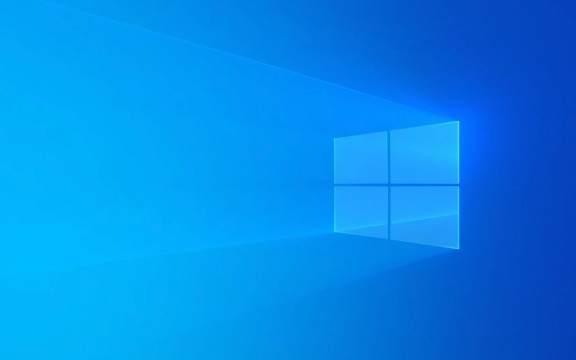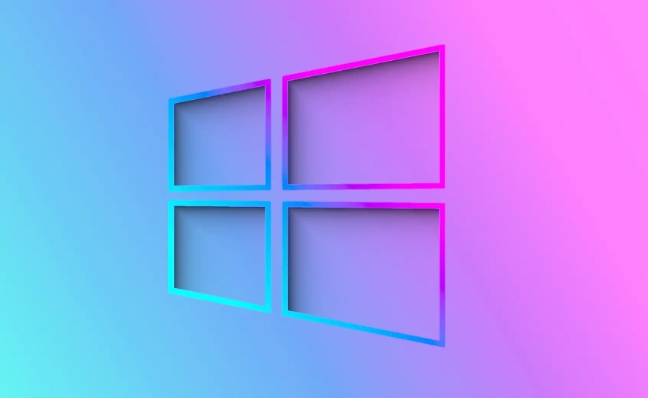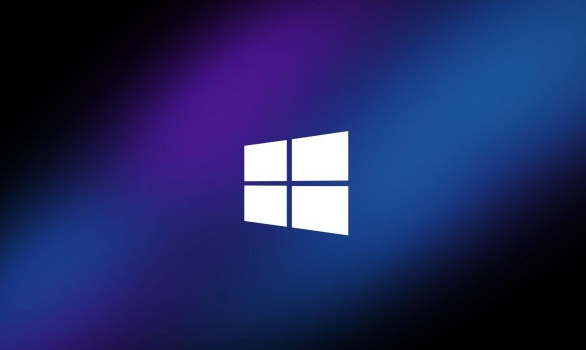Ensure network discovery and file sharing are enabled, set the network to "dedicated", and enable relevant options in advanced sharing settings; 2. Enable SMB 2.0/3.0 and network discovery functions through the control panel, and enable SMB1 if necessary (only for legacy devices); 3. Check the sharing and security rights of shared folders to ensure that everyone or corresponding users have read or modify permissions; 4. Use the same Microsoft account or matching local account on both PCs, or turn off password-protected sharing to simplify access; 5. Check whether the Windows firewall allows "File and Printer Sharing" and "Network Discovery" to pass, and temporarily disable third-party antivirus software if necessary; 6. Restart key network services such as FDResPub and SSDPSRV as an administrator; 7. Use ping and IP addresses (such as \192.168.xx) to test connectivity to confirm whether it is a name resolution problem; finally make sure that the two devices are on the same subnet, avoid isolating the network, and complete system updates and restarts. The problem can usually be solved by correctly configuring network discovery, sharing permissions and firewall settings.

File sharing not working over a network in Windows 11 is a common issue, especially after updates or when setting up a new PC. The problem can stem from incorrect network settings, disabled sharing features, or firewall restrictions. Here's how to troubleshoot and fix it step by step.

? 1. Check Network Discovery and File Sharing Settings
Windows 11 must be set to discover other devices and allow file sharing on the current network.
Steps:

- Press
Win Ito open Settings . - Go to Network & internet > Advanced network settings > Advanced sharing settings .
- Under the Private network profile (or the one you're using), ensure these options are turned on:
- Turn on network discovery
- Turn on file and printer sharing
- Turn on sharing so anyone with a Microsoft account can read and write files
- Under All networks , check:
- Turn on password protected sharing (disable this if you're having trouble accessing shared folders from other PCs on the same network).
? If you're on a "Public" network, switch it to Private . Windows restricts sharing on public networks by default.
To change network profile:

- Go to Settings > Network & internet > Wi-Fi (or Ethernet).
- Click on your network > Set as Private .
? 2. Enable Required Sharing Features via Control Panel
Some legacy sharing components are only accessible through the Control Panel.
Steps:
- Open Control Panel (search for it in Start).
- Go to Programs > Turn Windows features on or off .
- Make sure these are checked:
- ?? SMB 1.0/CIFS File Sharing Support (not recommended for security, but needed for older devices)
- ?? SMB 2.0/3.0 (enabled by default, but confirm)
- ?? Network Discovery (LLMNR) and Function Discovery should be on
- Restart your PC if you made changes.
?? Note: SMB1 is outdated and insecure. Only enable it if absolutely necessary (eg, sharing with older NAS or Windows 7 devices).
? 3. Verify Sharing Permissions
Even if sharing is enabled, incorrect permissions can block access.
On the host PC (the one sharing the folder):
- Right-click the folder > Properties > Sharing tab.
- Click Advanced Sharing > Check Share this folder .
- Click Permissions > Ensure Everyone has at least Read (or Change if needed).
- Click OK .
Also check Security tab in Properties:
- Click Edit > Add Everyone if missing.
- Give Read & execute , List folder contents , Read (and Modify if needed).
- Apply changes.
? 4. Use the Same Microsoft Account or Set Up Matching Local Accounts
Windows 11 may prompt for a username and password when accessing shared folders.
Fix options:
- Use a local account with the same username and password on both PCs.
- Or, sign in with the same Microsoft account on both devices.
- Alternatively, disable password-protected sharing (Settings > Advanced sharing settings > All networks > Turn off password protected sharing).
?? Disabling password-protected sharing is less secure but simplifies access on trusted home networks.
? 5. Check Windows Firewall and Antivirus
Firewall settings can block file and printer sharing.
Steps:
- Go to Control Panel > Windows Defender Firewall .
- Click Allow an app or feature through Windows Defender Firewall .
- Ensure these are allowed for Private (and possible Public) networks:
- ?? File and Printer Sharing (SMB-In)
- ?? Network Discovery (LLMNR-UDP-In, etc.)
If you're using third-party antivirus (like Norton, McAfee), temporarily disable it to test if it's interfering.
? 6. Restart Network Services
Sometimes the SSDP or Function Discovery services get stuck.
Run as Administrator (Command Prompt or PowerShell):
net stop fdrespub net start fdrespub net stop SSDPSRV net start SSDPSRV
You can also restart the Computer Browser and Server services via services.msc .
? 7. Test Connectivity
Before troubleshooting further, confirm basic network communication.
On the client PC, open Command Prompt and run:
ping [Host-PC-IP]
(Replace with the actual IP of the PC hosting the shared folder.)
Find the IP: On the host, run
ipconfigand look for IPv4 Address .-
Try accessing via IP:
- Open File Explorer > Type
\\192.168.xx(the host's IP) in the address bar.
- Open File Explorer > Type
- Make sure both PCs are on the same network/subnet .
- Avoid Wi-Fi hotspots or guest networks that isolate devices.
- Update Windows: Go to Settings > Windows Update and install pending updates.
- Reboot both devices after major changes.
If this works but the PC name doesn't, it's a network name resolution issue (often fixed by enabling LLMNR or using IP addresses temporarily).
Final Tips
Basically, file sharing issues in Windows 11 usually come down to network profile settings, sharing permissions, or firewall blocks. Go through each step carefully—most cases are resolved by enabling network discovery and adjusting sharing settings.
The above is the detailed content of File sharing not working over network in Windows 11. For more information, please follow other related articles on the PHP Chinese website!

Hot AI Tools

Undress AI Tool
Undress images for free

Undresser.AI Undress
AI-powered app for creating realistic nude photos

AI Clothes Remover
Online AI tool for removing clothes from photos.

Clothoff.io
AI clothes remover

Video Face Swap
Swap faces in any video effortlessly with our completely free AI face swap tool!

Hot Article

Hot Tools

Notepad++7.3.1
Easy-to-use and free code editor

SublimeText3 Chinese version
Chinese version, very easy to use

Zend Studio 13.0.1
Powerful PHP integrated development environment

Dreamweaver CS6
Visual web development tools

SublimeText3 Mac version
God-level code editing software (SublimeText3)

Hot Topics
 Windows 11 slow boot time fix
Jul 04, 2025 am 02:04 AM
Windows 11 slow boot time fix
Jul 04, 2025 am 02:04 AM
The problem of slow booting can be solved by the following methods: 1. Check and disable unnecessary booting programs; 2. Turn off the quick boot function; 3. Update the driver and check disk health; 4. Adjust the number of processor cores (only for advanced users). For Windows 11 systems, first, the default self-start software such as QQ and WeChat are disabled through the task manager to improve the startup speed; if you use dual systems or old hardware, you can enter the power option to turn off the quick boot function; second, use the device manager to update the driver and run the chkdsk command to fix disk errors, and it is recommended to replace the mechanical hard disk with SSD; for multi-core CPU users, the kernel parameters can be adjusted through bcdedit and msconfig to optimize the startup efficiency. Most cases can be corrected by basic investigation
 How to Change Font Color on Desktop Icons (Windows 11)
Jul 07, 2025 pm 12:07 PM
How to Change Font Color on Desktop Icons (Windows 11)
Jul 07, 2025 pm 12:07 PM
If you're having trouble reading your desktop icons' text or simply want to personalize your desktop look, you may be looking for a way to change the font color on desktop icons in Windows 11. Unfortunately, Windows 11 doesn't offer an easy built-in
 Fixed Windows 11 Google Chrome not opening
Jul 08, 2025 pm 02:36 PM
Fixed Windows 11 Google Chrome not opening
Jul 08, 2025 pm 02:36 PM
Fixed Windows 11 Google Chrome not opening Google Chrome is the most popular browser right now, but even it sometimes requires help to open on Windows. Then follow the on-screen instructions to complete the process. After completing the above steps, launch Google Chrome again to see if it works properly now. 5. Delete Chrome User Profile If you are still having problems, it may be time to delete Chrome User Profile. This will delete all your personal information, so be sure to back up all relevant data. Typically, you delete the Chrome user profile through the browser itself. But given that you can't open it, here's another way: Turn on Windo
 How to fix second monitor not detected in Windows?
Jul 12, 2025 am 02:27 AM
How to fix second monitor not detected in Windows?
Jul 12, 2025 am 02:27 AM
When Windows cannot detect a second monitor, first check whether the physical connection is normal, including power supply, cable plug-in and interface compatibility, and try to replace the cable or adapter; secondly, update or reinstall the graphics card driver through the Device Manager, and roll back the driver version if necessary; then manually click "Detection" in the display settings to identify the monitor to confirm whether it is correctly identified by the system; finally check whether the monitor input source is switched to the corresponding interface, and confirm whether the graphics card output port connected to the cable is correct. Following the above steps to check in turn, most dual-screen recognition problems can usually be solved.
 Fixed the failure to upload files in Windows Google Chrome
Jul 08, 2025 pm 02:33 PM
Fixed the failure to upload files in Windows Google Chrome
Jul 08, 2025 pm 02:33 PM
Have problems uploading files in Google Chrome? This may be annoying, right? Whether you are attaching documents to emails, sharing images on social media, or submitting important files for work or school, a smooth file upload process is crucial. So, it can be frustrating if your file uploads continue to fail in Chrome on Windows PC. If you're not ready to give up your favorite browser, here are some tips for fixes that can't upload files on Windows Google Chrome 1. Start with Universal Repair Before we learn about any advanced troubleshooting tips, it's best to try some of the basic solutions mentioned below. Troubleshooting Internet connection issues: Internet connection
 Want to Build an Everyday Work Desktop? Get a Mini PC Instead
Jul 08, 2025 am 06:03 AM
Want to Build an Everyday Work Desktop? Get a Mini PC Instead
Jul 08, 2025 am 06:03 AM
Mini PCs have undergone
 Is the latest Windows update safe to install
Jul 02, 2025 am 01:04 AM
Is the latest Windows update safe to install
Jul 02, 2025 am 01:04 AM
Microsoft's latest Windows updates can generally be installed safely, but they need to be judged based on the update type and usage scenario. Ordinary users can update their daily office work, video watching, etc. directly; professional software or game users should be cautious. Regular quality updates (such as the monthly "Tuesday Patch") have low risks, so it is recommended to install them in time; updates to functions (such as large version upgrades) may cause compatibility issues. It is recommended to back up data, confirm software and hardware support, and check community feedback before installing. Overall, quality updates are safe and reliable, and functional updates are suitable for optional installation after observation.







